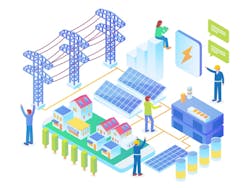American Electric Power (AEP) unveiled plans this week to invest $52 million to build 8-10 utility microgrids as part of a smart city design for Columbus, Ohio.
AEP Ohio filed the microgrid proposal with the Public Utilities Commission of Ohio as part of an update to the utility’s Electric Security Plan.
The proposal makes AEP the latest in a series of U.S. utility giants pursuing microgrids, among them Duke Energy, Exelon, Edison International, National Grid, PG&E, PSEG, Southern Company and Xcel Energy.
AEP plans to install the microgrids over four years at critical facilities, such as police and fire stations, hospitals, social service centers, shelters, water and sewer infrastructure, grocery stores and gas stations. The utility intends to let other nearby customers connect their on-site generation to a microgrid for a fee.
The 8-10 microgrids are the first phase of AEP’s microgrid rollout; the utility plans additional projects later.
“AEP Ohio hopes that this initial demonstration project will create the blueprint for additional, larger-scale microgrid deployment to be proposed in a later proceeding,” said Scott Osterholt, AEP Ohio’s director of distribution risk and project management, in testimony before the commission.
In addition to the $52 million, AEP seeks approval to recover $1.5 million per year for microgrid operations and maintenance. The utility plans to recoup the microgrid costs through a distribution technology rider on customer bills.
Source: Testimony of Scott Osterholt, PUCO.Case No. 16-1852-EL-SSO, Case No. 16-1853-EL-AAM
Smart city proposal
In June, Columbus became the sole winner of a $40 million grant from the Department of Transportation for smart city development. As a partner in the project, AEP Ohio pledged to undertake strategies to decarbonize power supply and boost electric vehicles. AEP offered the microgrids to honor the commitment, along with 250 EV charger installations, smart light controls, and other power-related improvements.
The utility will seek microgrid opportunities in the Smart Columbus footprint, as well as other areas of its service territory. Criteria for selecting sites include:
- Critical nature of the customer loads that would benefit from the microgrid – for example, whether the load is a hospital or public safety building
- Amount of customer load (size, type, etc.)
- The amount of existing backup generation already available for the customer loads
- The historic reliability of the circuit serving the customer loads (i.e., three-year average SAIDI)
“As with the proposed electric vehicle charging stations, the company intends to seek input from Smart Columbus representatives regarding the locations that would most benefit from a microgrid,” said Osterholt in the testimony.
AEP also said it intends to place special focus on using the microgrids to serve low-income customers.
Benefits of utility microgrids
Osterholt cited several benefits AEP Ohio expects to derive from the utility microgrids, among them improved reliability, reduced system peak demand and intergration of renewable generation.
The microgrids will include solar plus storage with natural gas turbines serving as the marginal system resource. AEP expects this configuration to reduce greenhouse gases by 3,176 tons per year, as well as avoid some sulfur dioxide, particulate matter, and other emissions.
Source: Testimony of Scott Osterholt, PUCO.Case No. 16-1852-EL-SSO, Case No. 16-1853-EL-AAM
Osterholt noted another benefit — the grid-connected microgrids can offer ancillary services and demand response in the PJM market.
“According to the Energy Storage Association, battery storage can respond to electric control area operator requests to adjust power output considerably faster and more accurately than can combustion turbine generators,” he said.
Competitive issues
In other restructured states, such as Illinois, Maryland, Pennsylvania, utility microgrids have run into opposition from pro-competition forces who say private companies, not utilities, should develop microgrids.
Osterholt argued that utility microgrids play a role that private microgrids cannot.
“Although there are third-party vendors that install private microgrid systems, these private microgrids are installed behind the utility meter and benefit a single customer,” he said.
Osterholt said that AEP Ohio does not intend to compete with these private systems. Instead the utility offers a different product: a utility-owned microgrid installed in front of the meter.
A utility microgrid serves multiple customers and interacts with the utility’s distribution grid in ways that private microgrid systems cannot, he said. For example, by integrating with the utility’s distribution system it can maximize the benefits of demand response and sectionalizing.
In addition to offering the microgrids, EV charging and lighting, the Electric Security Plan makes several other changes. It replaces aging infrastructure, creates a cost recovery mechanism for renewable generation, ramps up tree trimming and improves physical security for distribution substations.
The utility anticipates a commission decision on the plan in April 2017.
Did you know that 79 percent of those surveyed by Microgrid Knowledge favor utility ownership of microgrids? Read our full report here.







